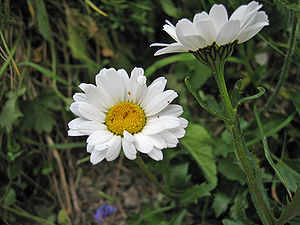Black-rimmed marguerite
| Black-rimmed marguerite | ||||||||||||
|---|---|---|---|---|---|---|---|---|---|---|---|---|

Black-rimmed Marguerite ( Leucanthemum atratum ) |
||||||||||||
| Systematics | ||||||||||||
|
||||||||||||
| Scientific name | ||||||||||||
| Leucanthemum atratum | ||||||||||||
| Jacq. |
The Schwarzrandige Marguerite ( Leucanthemum atratum ) is a flowering plant in the family of the daisy family (Asteraceae). The plant is also known as black-edged exuberant flower or saw-leaved magerite.
description
The herbaceous perennial plant reaches heights of 20 to 40 centimeters.
The bare, dark green leaves are a bit thick or fleshy. The basal leaves are usually long-stalked, with the blade narrowing into the petiole in a long wedge. They are roughly serrated to notched in front and usually have five to seven teeth. The central stem leaves are sessile and have almost triangular teeth (about twice as long as they are wide) that stand upright, with an angle of about 45 °.
On the unbranched stem sits a basket with white ray- flowers and yellow tubular flowers . The inflorescence reaches a diameter of three to five centimeters. The fruits of the flowers have a distinct crown. The bracts have a black border.
Flowering time is from June to September.
The species is hexaploid. The chromosome number is 2n = 54.
Possible confusion
The Steineralpen marguerite ( Leucanthemum lithopolitanicum ) (endemic to the Steiner Alps ) and the Haller's marguerite ( Leucanthemum halleri ) are also often confused with the black-rimmed marguerite due to the black bracts.
However, both species only grow to a height of between five and 20 centimeters, with elongated to linear teeth on the central stem leaves. These are protruding or bent back (angle more than 45 °). Both types are diploid. The species Leucanthemum atratum forms together with four other species ( Leucanthemum lithopolitanicum , Leucanthemum halleri , Leucanthemum coronopifolium and Leucanthemum tridactylites ) the so-called Leucanthemum atratum aggregate . Together with the so-called Leucanthemum vulgare aggregate, these two clan groups form a small-species taxon that is difficult to distinguish and inhabit almost exclusively alpine vegetation zones (please note the exception of Leucanthemum ircutianum ).
Location and distribution
The limestone black-rimmed marguerite is endemic to the north-eastern Limestone Alps and only occurs from the Höllengebirge to the Schneeberg . Rock corridors , rubble and rubble snow soils are preferred as locations . The plant can be found scattered in the federal states of Upper Austria , Lower Austria and northern Styria from subalpine to alpine altitude . It is a species of the order Thlaspietalia rotundifolii.
Sources and further information
literature
- Manfred A. Fischer , Wolfgang Adler, Karl Oswald: Excursion flora for Austria, Liechtenstein and South Tyrol. 2nd, improved and enlarged edition. State of Upper Austria, Biology Center of the Upper Austrian State Museums, Linz 2005, ISBN 3-85474-140-5 .
- Muer, Angerer: Alpine Plants , Stuttgart 2004, ISBN 3-8001-3374-1
Individual evidence
- ↑ a b Erich Oberdorfer : Plant-sociological excursion flora for Germany and neighboring areas . With the collaboration of Angelika Schwabe and Theo Müller. 8th, heavily revised and expanded edition. Eugen Ulmer, Stuttgart (Hohenheim) 2001, ISBN 3-8001-3131-5 , pp. 939 .